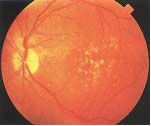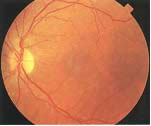Age-Related Macular Degeneration (AMD) |
AMD is a common eye disease associated with aging that gradually destroys sharp, central vision. Central vision is needed for seeing objects clearly and for common daily tasks such as reading and driving. In some people, AMD advances so slowly that it will have little effect on their vision as they age. But in others, the disease progresses faster and may lead to a loss of vision in one or both eyes.
|


|
Types
AMD occurs in two forms. Wet (vascular) and dry (atrophic). Although only ten percent of all people with AMD have wet AMD, it is responsible for the vast majority of severe, AMD-related vision losses. As dry AMD worsens, new blood vessels may begin to grow and cause wet AMD. Because these new blood vessels tend to be very fragile, they will often leak blood and fluid under the macula. This causes rapid damage to the macula that can lead to the loss of central vision in a short period of time.
Dry AMD affects the other ninety percent of cases. The earliest sign of dry AMD is the development of waste material deposits, called drusen, that appear as tiny orange or yellow dots among the retinal pigment epithelial cells. These deposits are initially tiny and few in number, but they may grow larger and become more numerous. Scientists are still not sure what causes dry AMD. Studies suggest that an area of the retina becomes diseased, leading to the slow breakdown of the light-sensing cells in the macula and a gradual loss of central vision.
Causes
Most cases of macular degeneration are age-related, meaning older people are more likely to have it. Risk factors include: being white or female, having a family member with AMD, smoking, high blood pressure, farsightedness and obesity. The exact causes are still unknown. Because the condition often runs in families, AMD may be hereditary.
Symptoms
The main symptom is central vision loss, which is gradual in dry AMD and sudden in wet AMD. Other symptoms include blurry or fuzzy vision, dark spots in the center of vision, difficulty reading or performing detail work; and seeing straight lines as wavy or bent.
Treatments
No treatment currently exists for dry AMD. It has been suggested that taking certain extra vitamins and minerals may slow the progress of the disease. But this treatment needs much more research before scientists can know for sure if it's helpful.
There are two FDA approved treatments available for wet macular degeneration: photocoagulation and photodynamic therapy.
Surgeons use laser photocoagulation to treat leakage that results from wet AMD. The laser beam burns abnormal blood vessels to seal the leakage. By slowing or stopping the leakage, the progression of macular degeneration is also slowed or stopped. Only about one-tenth of patients with wet AMD are candidates for this procedure.
Photodynamic therapy (PDT) is a minimally invasive outpatient procedure. The procedure involves a light-activated drug and low-intensity, or non-thermal, laser light. The eye is numbed with eye drops and a special contact lens is placed on the eye. The light-activated drug is then administered intravenously. The laser light is directed through the contact lens to the affected area of the retina and closes up leaky blood vessels. Patients may require recurrent treatments as often as every 3 months for the first year. After the first year, treatment is required less frequently.
A new drug theraphy called Lucentis shows promise in certain types of wet AMD. Although costly, this intravitreal injection, which is repeated at intervals, can reduce the effects of AMD. Ask your eye doctor if this treatment is right for you.
|
|
|

